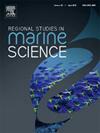Post-harvest loss assessment of Hilsa (Tenualosa ilisha) along the value chain in Bangladesh
IF 2.1
4区 环境科学与生态学
Q3 ECOLOGY
引用次数: 0
Abstract
Hilsa, the national fish of Bangladesh, contributes more than 12 % of the country's total fish production. Considering the species' importance, this study assessed the post-harvest loss (PHL) of Hilsa across the value chain. Data were collected at the landing and distribution chain from 200 fisherman, 40 aratdars (Aratdar-I), 40 wholesalers at landing sites of the Chandpur district, 40 aratdars (Aratdar-II), and 70 retailers at the distribution sites of the Jamalpur district. The results revealed 12.56 % post-harvest losses in the value chains, most of which were caused by quality losses (8.41 %). Along the value chain, fishermen faced the highest losses 5.291 %, followed by 3.813 % in the retailers. These findings suggest fishermen and retail markets are hotspots of spoilage and fish loss. The OLS regression model indicated that inappropriate age and lack of experience of stakeholders, prolonged harvesting time, inadequate washing facilities, fishermen small size group, longer distances between fishing locations and landing sites, lack of proper education and training, delaying auctioning, insufficient infrastructure facilities, longer selling time, and insufficient cooling facilities were the significant factors causing PHL in the value chain. Nutritional analysis revealed substantial changes across the value chain. Moisture content increased steadily, which accelerated the spoilage. A significant decrease in protein, lipid and ash indicated the substantial loss of nutrients after harvesting up to the retail market. Principal Component Analysis (PCA) for nutritional composition analyses demonstrated that after the catch, aratdar-I, and boat had higher nutrient levels, while aratdar-II, local wholesaler, and post-transportation had higher moisture and lower nutrient levels. The PC1 accounted 95.92 % of the variation, indicating that handling and storage had significant influences in maintaining nutritional quality. To reduce post-harvest losses, the government must implement standardized practices throughout the Hilsa value chain to ensure food security and sustainability in the Hilsa fishery and boost the economy.
沿价值链对孟加拉国 Hilsa(Tenualosa ilisha)收获后损失的评估
Hilsa 是孟加拉国的国鱼,占该国鱼类总产量的 12%以上。考虑到该鱼种的重要性,本研究评估了希尔萨鱼在整个价值链中的收获后损失(PHL)。研究人员在上岸和分销环节收集了 200 名渔民、40 名 aratdars(Aratdar-I)、Chandpur 地区上岸点的 40 名批发商、40 名 aratdars(Aratdar-II)以及 Jamalpur 地区分销点的 70 名零售商的数据。结果显示,价值链中收获后损失占 12.56%,其中大部分是质量损失(8.41%)造成的。在价值链中,渔民面临的损失最高,为 5.291%,其次是零售商的 3.813%。这些结果表明,渔民和零售市场是水产品变质和损失的热点。OLS 回归模型表明,利益相关者年龄不当和缺乏经验、捕捞时间过长、清洗设施不足、渔民规模小、捕捞地点和上岸地点之间距离较远、缺乏适当的教育和培训、拍卖延迟、基础设施不足、销售时间较长以及冷却设施不足是造成价值链中 PHL 的重要因素。营养分析表明,整个价值链都发生了重大变化。水分含量持续增加,加速了变质。蛋白质、脂肪和灰分的大幅下降表明,从收获到零售市场,营养成分大量流失。营养成分分析的主成分分析(PCA)表明,在捕捞后,Aratdar-I 和船上的营养成分含量较高,而 Aratdar-II、当地批发商和运输后的水分含量较高,营养成分含量较低。PC1 占变异的 95.92%,表明处理和贮藏对保持营养质量有显著影响。为了减少收获后的损失,政府必须在整个 Hilsa 价值链中实施标准化操作,以确保 Hilsa 渔业的粮食安全和可持续性,并促进经济发展。
本文章由计算机程序翻译,如有差异,请以英文原文为准。
求助全文
约1分钟内获得全文
求助全文
来源期刊

Regional Studies in Marine Science
Agricultural and Biological Sciences-Ecology, Evolution, Behavior and Systematics
CiteScore
3.90
自引率
4.80%
发文量
336
审稿时长
69 days
期刊介绍:
REGIONAL STUDIES IN MARINE SCIENCE will publish scientifically sound papers on regional aspects of maritime and marine resources in estuaries, coastal zones, continental shelf, the seas and oceans.
 求助内容:
求助内容: 应助结果提醒方式:
应助结果提醒方式:


